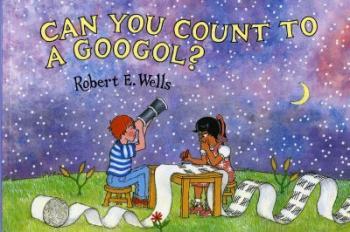
scrounge: /skrounj/ informal verb: to actively seek [books] from any available source

A while ago, in this post, I wrote about some titles in Robert E. Wells' science series that we've really enjoyed. We've since read a few more books from this series that we've enjoyed just as much, so I decided we needed a "part two."
The first is Can You Count to a Googol?, which uses creative illustrations and simple mathematical concepts to introduce students to progressively larger numbers -- from one, to ten, to one hundred (with the reminder that each zero at the end makes a number ten times bigger), to even more. The visualizations include baskets full of marshmallows, penguins eating many scoops of ice cream, and dollar bills packed onto pallets. The end blew our minds a bit as we tried to understand just how big a googol is (one with one hundred zeroes after it). Even then, the reminder that numbers never end gives a lot of perspective as we contemplate outer space and other things so much bigger than us. This book is similar to How Much Is a Million?, a memorable Reading Rainbow book, but I appreciate that this one walks us through even larger numbers and is more clear about how to get from one to another.
The next is Did a Dinosaur Drink This Water?, which is a very thorough exploration of the water system (dinosaur-loving kids may be disappointed to find out that this isn't really about dinosaurs, but it does emphasize how water molecules have been recycled over and over for a very long time). Since it mentions water molecules, this might be an interesting follow-up to What's Smaller Than a Pygmy Shrew? It covers fresh vs. salt water, how water is naturally cleaned and filtered, evaporation and rain, hydroelectricity, and also a bit about conservation at the end, which actually follows well from the text and doesn't feel "tacked on" like these things sometimes do.
Lastly, we've also enjoyed How Do You Know What Time It Is?, which is one of the more thorough titles we've read since it covers aspects of both science and history, and it may be harder for younger children to follow. But it does a great job introducting children to the concept of time, and how we don't even really know what it is. The history comes in when it discusses many of the earlier methods that people used to measure time, such as sun dials, water clocks, and solar vs. lunar calendars. From there it goes into earth's rotation and orbit, as well as time zones and other complications of measuring time. I appreciated the science and history, but also the straightforwardness about mystery, and how much science still hasn't been able to tell us about many concepts, such as time.
Scrounged From: Our local library and AbeBooks.com

